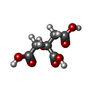[English] 日本語
 Yorodumi
Yorodumi- PDB-8bp7: Citrate-bound hexamer of Synechococcus elongatus citrate synthase -
+ Open data
Open data
- Basic information
Basic information
| Entry | Database: PDB / ID: 8bp7 | ||||||
|---|---|---|---|---|---|---|---|
| Title | Citrate-bound hexamer of Synechococcus elongatus citrate synthase | ||||||
 Components Components | Citrate synthase | ||||||
 Keywords Keywords | TRANSFERASE / Krebs-cycle / TCA-cycle / szierpinski triangle | ||||||
| Function / homology |  Function and homology information Function and homology informationcitrate synthase activity / tricarboxylic acid cycle / carbohydrate metabolic process / metal ion binding / cytosol Similarity search - Function | ||||||
| Biological species |  Synechococcus elongatus PCC 7942 = FACHB-805 (bacteria) Synechococcus elongatus PCC 7942 = FACHB-805 (bacteria) | ||||||
| Method |  X-RAY DIFFRACTION / X-RAY DIFFRACTION /  SYNCHROTRON / SYNCHROTRON /  MOLECULAR REPLACEMENT / Resolution: 2.71 Å MOLECULAR REPLACEMENT / Resolution: 2.71 Å | ||||||
 Authors Authors | Mais, C.-N. / Sendker, F. / Bange, G. | ||||||
| Funding support | 1items
| ||||||
 Citation Citation |  Journal: Nature / Year: 2024 Journal: Nature / Year: 2024Title: Emergence of fractal geometries in the evolution of a metabolic enzyme. Authors: Franziska L Sendker / Yat Kei Lo / Thomas Heimerl / Stefan Bohn / Louise J Persson / Christopher-Nils Mais / Wiktoria Sadowska / Nicole Paczia / Eva Nußbaum / María Del Carmen Sánchez ...Authors: Franziska L Sendker / Yat Kei Lo / Thomas Heimerl / Stefan Bohn / Louise J Persson / Christopher-Nils Mais / Wiktoria Sadowska / Nicole Paczia / Eva Nußbaum / María Del Carmen Sánchez Olmos / Karl Forchhammer / Daniel Schindler / Tobias J Erb / Justin L P Benesch / Erik G Marklund / Gert Bange / Jan M Schuller / Georg K A Hochberg /    Abstract: Fractals are patterns that are self-similar across multiple length-scales. Macroscopic fractals are common in nature; however, so far, molecular assembly into fractals is restricted to synthetic ...Fractals are patterns that are self-similar across multiple length-scales. Macroscopic fractals are common in nature; however, so far, molecular assembly into fractals is restricted to synthetic systems. Here we report the discovery of a natural protein, citrate synthase from the cyanobacterium Synechococcus elongatus, which self-assembles into Sierpiński triangles. Using cryo-electron microscopy, we reveal how the fractal assembles from a hexameric building block. Although different stimuli modulate the formation of fractal complexes and these complexes can regulate the enzymatic activity of citrate synthase in vitro, the fractal may not serve a physiological function in vivo. We use ancestral sequence reconstruction to retrace how the citrate synthase fractal evolved from non-fractal precursors, and the results suggest it may have emerged as a harmless evolutionary accident. Our findings expand the space of possible protein complexes and demonstrate that intricate and regulatable assemblies can evolve in a single substitution. | ||||||
| History |
|
- Structure visualization
Structure visualization
| Structure viewer | Molecule:  Molmil Molmil Jmol/JSmol Jmol/JSmol |
|---|
- Downloads & links
Downloads & links
- Download
Download
| PDBx/mmCIF format |  8bp7.cif.gz 8bp7.cif.gz | 444.3 KB | Display |  PDBx/mmCIF format PDBx/mmCIF format |
|---|---|---|---|---|
| PDB format |  pdb8bp7.ent.gz pdb8bp7.ent.gz | 366.8 KB | Display |  PDB format PDB format |
| PDBx/mmJSON format |  8bp7.json.gz 8bp7.json.gz | Tree view |  PDBx/mmJSON format PDBx/mmJSON format | |
| Others |  Other downloads Other downloads |
-Validation report
| Summary document |  8bp7_validation.pdf.gz 8bp7_validation.pdf.gz | 3.2 MB | Display |  wwPDB validaton report wwPDB validaton report |
|---|---|---|---|---|
| Full document |  8bp7_full_validation.pdf.gz 8bp7_full_validation.pdf.gz | 3.4 MB | Display | |
| Data in XML |  8bp7_validation.xml.gz 8bp7_validation.xml.gz | 95.9 KB | Display | |
| Data in CIF |  8bp7_validation.cif.gz 8bp7_validation.cif.gz | 126.6 KB | Display | |
| Arichive directory |  https://data.pdbj.org/pub/pdb/validation_reports/bp/8bp7 https://data.pdbj.org/pub/pdb/validation_reports/bp/8bp7 ftp://data.pdbj.org/pub/pdb/validation_reports/bp/8bp7 ftp://data.pdbj.org/pub/pdb/validation_reports/bp/8bp7 | HTTPS FTP |
-Related structure data
| Related structure data | 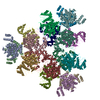 8an1C 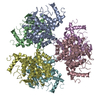 8beiSC 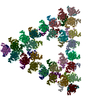 8rjkC 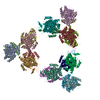 8rjlC S: Starting model for refinement C: citing same article ( |
|---|---|
| Similar structure data | Similarity search - Function & homology  F&H Search F&H Search |
- Links
Links
- Assembly
Assembly
| Deposited unit | 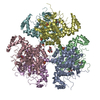
| ||||||||
|---|---|---|---|---|---|---|---|---|---|
| 1 |
| ||||||||
| Unit cell |
|
- Components
Components
| #1: Protein | Mass: 44367.371 Da / Num. of mol.: 6 Source method: isolated from a genetically manipulated source Source: (gene. exp.)  Synechococcus elongatus PCC 7942 = FACHB-805 (bacteria) Synechococcus elongatus PCC 7942 = FACHB-805 (bacteria)Gene: Synpcc7942_0612 / Production host:  #2: Chemical | ChemComp-SO4 / #3: Chemical | ChemComp-CIT / #4: Chemical | ChemComp-MG / #5: Water | ChemComp-HOH / | Has ligand of interest | Y | |
|---|
-Experimental details
-Experiment
| Experiment | Method:  X-RAY DIFFRACTION / Number of used crystals: 1 X-RAY DIFFRACTION / Number of used crystals: 1 |
|---|
- Sample preparation
Sample preparation
| Crystal | Density Matthews: 4.3 Å3/Da / Density % sol: 71.37 % |
|---|---|
| Crystal grow | Temperature: 293 K / Method: vapor diffusion, sitting drop / pH: 5.5 / Details: 0.1 M citrate pH 5.5, 2.0 M ammonium sulfate |
-Data collection
| Diffraction | Mean temperature: 100 K / Serial crystal experiment: N |
|---|---|
| Diffraction source | Source:  SYNCHROTRON / Site: SYNCHROTRON / Site:  PETRA III, EMBL c/o DESY PETRA III, EMBL c/o DESY  / Beamline: P13 (MX1) / Wavelength: 0.97626 Å / Beamline: P13 (MX1) / Wavelength: 0.97626 Å |
| Detector | Type: DECTRIS EIGER X 16M / Detector: PIXEL / Date: Oct 14, 2021 |
| Radiation | Protocol: SINGLE WAVELENGTH / Monochromatic (M) / Laue (L): M / Scattering type: x-ray |
| Radiation wavelength | Wavelength: 0.97626 Å / Relative weight: 1 |
| Reflection | Resolution: 2.71→49.39 Å / Num. obs: 127720 / % possible obs: 99.9 % / Redundancy: 28.6 % / CC1/2: 0.998 / Net I/σ(I): 9.19 |
| Reflection shell | Resolution: 2.71→2.807 Å / Mean I/σ(I) obs: 0.68 / Num. unique obs: 12503 / CC1/2: 0.25 |
- Processing
Processing
| Software |
| |||||||||||||||||||||||||||||||||||||||||||||||||||||||||||||||||||||||||||||||||||||||||||||||||||||||||||||||||||||||||||||||||||||||||||||||||||||||||||||||||||||||||||||||||||||||||||||||||||||||||||||||||||||||||
|---|---|---|---|---|---|---|---|---|---|---|---|---|---|---|---|---|---|---|---|---|---|---|---|---|---|---|---|---|---|---|---|---|---|---|---|---|---|---|---|---|---|---|---|---|---|---|---|---|---|---|---|---|---|---|---|---|---|---|---|---|---|---|---|---|---|---|---|---|---|---|---|---|---|---|---|---|---|---|---|---|---|---|---|---|---|---|---|---|---|---|---|---|---|---|---|---|---|---|---|---|---|---|---|---|---|---|---|---|---|---|---|---|---|---|---|---|---|---|---|---|---|---|---|---|---|---|---|---|---|---|---|---|---|---|---|---|---|---|---|---|---|---|---|---|---|---|---|---|---|---|---|---|---|---|---|---|---|---|---|---|---|---|---|---|---|---|---|---|---|---|---|---|---|---|---|---|---|---|---|---|---|---|---|---|---|---|---|---|---|---|---|---|---|---|---|---|---|---|---|---|---|---|---|---|---|---|---|---|---|---|---|---|---|---|---|---|---|---|
| Refinement | Method to determine structure:  MOLECULAR REPLACEMENT MOLECULAR REPLACEMENTStarting model: 8BEI Resolution: 2.71→49.39 Å / SU ML: 0.51 / Cross valid method: FREE R-VALUE / σ(F): 1.34 / Phase error: 30.22 / Stereochemistry target values: ML
| |||||||||||||||||||||||||||||||||||||||||||||||||||||||||||||||||||||||||||||||||||||||||||||||||||||||||||||||||||||||||||||||||||||||||||||||||||||||||||||||||||||||||||||||||||||||||||||||||||||||||||||||||||||||||
| Solvent computation | Shrinkage radii: 0.9 Å / VDW probe radii: 1.11 Å / Solvent model: FLAT BULK SOLVENT MODEL | |||||||||||||||||||||||||||||||||||||||||||||||||||||||||||||||||||||||||||||||||||||||||||||||||||||||||||||||||||||||||||||||||||||||||||||||||||||||||||||||||||||||||||||||||||||||||||||||||||||||||||||||||||||||||
| Refinement step | Cycle: LAST / Resolution: 2.71→49.39 Å
| |||||||||||||||||||||||||||||||||||||||||||||||||||||||||||||||||||||||||||||||||||||||||||||||||||||||||||||||||||||||||||||||||||||||||||||||||||||||||||||||||||||||||||||||||||||||||||||||||||||||||||||||||||||||||
| Refine LS restraints |
| |||||||||||||||||||||||||||||||||||||||||||||||||||||||||||||||||||||||||||||||||||||||||||||||||||||||||||||||||||||||||||||||||||||||||||||||||||||||||||||||||||||||||||||||||||||||||||||||||||||||||||||||||||||||||
| LS refinement shell |
|
 Movie
Movie Controller
Controller






 PDBj
PDBj



